Truckstop
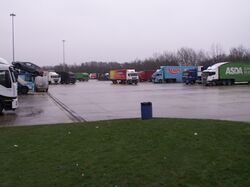
A truckstop is a service area which is primarily aimed at lorry drivers, providing somewhere to park, eat and use toilets and showers.
As of the 2010 regulations, truckstops officially come in two forms: MT (motorway truckstop, a truckstop which is signposted from a motorway) and TRT (trunk road truckstop, a truckstop which is signposted from a non-motorway trunk road).
In practice there is an important third category: a place which provides the necessary facilities but (be it by choice or due to regulations) isn't signposted from the road. This website tends to only look at places which are officially recognised by the highway authorities, and that acknowledgment tends to be very inconsistent.
Despite a difficult history, some chains of truckstops do operate in small numbers, including Onroute Truckstops and the remains of the Stobart group. Some motorway operators have also recently shown a new commitment to HGV facilities, even if they still mostly prioritise cars.
The term "truckstop" is often conflated with lorry park. A lorry park is simply one facility that is provided, and it can form part of a truckstop, a service area or even stand on its own. England's National Highways offered this definition of "truckstop" in 2025:
Note that they only recognise truckstops which meet their requirements.
UK Truckstops
See also: Official truckstop map and Highways Agency Truckstop Guide
The following truckstops are officially signposted from a major trunk road. There are many more which aren't signed, or are only signed from more local roads, but those don't meet the government's definition given above - only these do:
- Ashford International truckstop (M20 at J10 and J10A)
- Barton Park (A1(M)/A1 at J56)
- Carlisle truckstop (A689 near M6 J44, north of Carlisle)
- Carnforth (A6 near M6 J35)
- Junction 29 truckstop (M1 at J29)
- J38 truckstop (M6 at J38)
- Lymm truckstop (M6 at J20 and M56 at J9)
- Newtonmore (A9 at Newtonmore)
- Penrith truckstop (A66 at M6 J40)
- Red Lion truckstop (A4500 near M1 J16)
- Rothwell truckstop (A14 at J3)
- Route 74 truckstop (M74 at J9 and J10)
- South Mimms (M25 at J23 and A1(M) at J1)
- Stibbington (A1 between Peterborough and Stamford)
Truckstop History
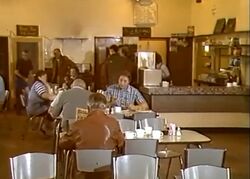
Before motorways were built, the A-roads were lined with cafés for lorry drivers. These are discussed further down, but key to the history is that many of these places made additional income by providing cheap accommodation, known as "digs". One facility at The Hollies, still trading on the modern A5 near Cannock, claims to be the UK's oldest. These facilities allowed the government to develop an attitude that HGV parking was a business matter, and if more accommodation was needed then they knew somebody would build it for them.
The motorways didn't change that. They had their own parking areas in the form of motorway service areas, but these were only designed for short stays and the government would only build them if they had a business who was willing to take responsibility for them. They did repeatedly consider creating motorway service areas for lorry drivers only, but that was always ruled out - partly because the businesses knew there was much less money to be made from HGVs.
What did change things was the invention of the sleeper cab, which haulage bosses loved because it meant that lorry drivers no longer had any reason to deviate from their route (and sometimes get up to go good) when they needed to sleep. The sleeper cabs created a new culture where HGVs would park anywhere and everywhere they could. In addition, drivers were now being closely monitored on their driving hours and route, so they couldn't head off looking for a better place to stop, even if they wanted to.
The watershed moment seemed to come at the start of the 1980s. By 1982 the motorway service area operators were on record begging the Department of Transport to do something about the amount of HGVs taking breaks in their tiny, short stay parking areas. They were happy to charge them for the experience - of course they were - but their concern was that they were so full they were routinely turning away lorry drivers, some of whom were so desperate for a break that they were parking in dangerous or disruptive locations.
Commercial Truckstops
There was clearly a market for a new generation of truckstops, which would have to be much larger than any of the traditional facilities from the 1950s. High construction costs and low profit margins meant there was only limited interest, and residents would usually oppose their development meaning it would be hard work to see the plans through.
Even so, there was some success: by the early 1990s a whole chain emerged called BP Truckstops, and there were three large, new sites signposted from the M6: Carnforth (part of the Truckhaven group), Lymm and J38 Truckstop.
BP sold their truckstops in 2002, apparently because the drop in fuel profit margins meant they could no longer justify the cost of attracting trucks. Their successor, Nightowl, had long-running financial problems. The industry appeared to be in retreat. Since then, more facilities have closed, especially the smaller ones.
High running costs and limited income streams have been blamed for the closures, with security being a particular issue, but arguably the biggest problem is the land value. A large parking area on the edge of a large city is often worth a lot of money to a land developer, so landowners were receiving large offers in exchange for selling the land.
21st Century
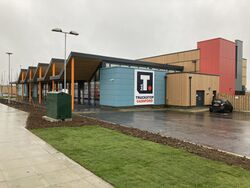
Highway authorities still appeared to be unsure how they should treat truckstops, with those named above being treated like motorway service areas, while others like J29 Truckstop only had signs referring to 'lorry parking'. This situation was clarified in 2008, with new regulations outlining what would be required before road signs would be provided. For the first time, a 'truckstop' was an official concept.
At the same time, England's national highway authority briefly began publishing its own detailed guide to commercial HGV facilities near their road network, but as with many initiatives, their interest was short-lived.
New truckstops did continue to open, but the high construction costs and limited income meant few businesses would consider it. A new truckstop needs to be large enough to handle a large number of heavy vehicle movements, and the developer needs to pay for a safe connection to the existing road network. There are also fewer opportunities to make money through social areas, hotels, or selling goods or food, as many drivers bring everything they want with them. Those who do build truckstops are often ex-hauliers who have personal experience of the difficulties drivers face.
The parking problems got worse, and it didn't help that new safety standards meant that many unofficial parking areas were now being closed. New regulations in 2010 permitted online motorway truckstops (truckstops which are directly accessible from the motorway and not via a junction). However, none have been built, due to there being no business interest. Despite none existing, the regulations governing them have been rewritten several times.
A major development was the opening of Rothwell Truckstop in 2019. As it was opened by motorway service area operator Welcome Break, who already operated a truckstop at South Mimms, it leaves open the opportunity of major motorway operators building more comprehensive truckstops. This was one of the first times there had been evidence of a major business being interested in HGV parking. There is an increased interest in eHGV charging, which will begin to take up more space at HGV facilities.
Since then, Moto tried to build their first new truckstop in 2021, to tackle the notorious HGV parking problems in Kent. There was also considerable media interest in the issues affecting lorry drivers, probably for the first time in their history, as a result of the UK's supply chain issues. Prime Minister Boris Johnson initially blamed haulage firms for not building the infrastructure. The strangely-titled Department for Levelling Up eventually announced that they would be arranging temporary facilities for lorry drivers, but there is little evidence of this happening. One government source suggested that "luxury lorry parks" were in the pipeline, which didn't happen.
Commenting on one private proposal in 2021, the national highway authority said "we are supportive of this type of development". That was the most encouraging statement they have made on the subject for a very long time. New regulations announced in 2022 acknowledged that there "may be a role for" highway authorities providing truckstops: in practice this seems very unlikely, but they may now help identify areas where one could be built. They were allocated funding so they could financially support improvements to HGV facilities in December 2023; this led to some improved parking areas, refurbished showers and some outdoor gym facilities.
Transport Focus, who run regular public satisfaction surveys that receive widespread media coverage, had their remit expanded to sample English HGV facilities in late 2023. They aimed to sample a third of HGV facilities positioned near an English trunk road. Their first report concluded that most HGV drivers were highly satisfied with their facilities, despite highlighting issues with provision, capacity, safety, noise and food.
Transport Cafés

A transport café (informally known as a truckers' café) is a restaurant reserved for HGV drivers only. They are different to truckstops in that they are there to provide food only, and their parking area is often informal and disorganised. Whatever the setting, the café would be a social space, with shared benches and sometimes pool tables, but not entertainment.
Transport cafés existed long before motorways, providing food and toilet facilities to lorry drivers. A survey in 1960 found that there were over 1,000 transport cafés in operation in the UK, but as motorways opened many of the old cafés would lose their trade. The ones which made most of their income from selling alcohol or hostel rooms particularly suffered, as those facilities fell out of favour.
When the first motorway service areas opened, transport cafés were an integral part of them. The reason was that lorry drivers and car drivers were generally different social classes, and neither wanted to mix with the other. The transport café was usually a cheaper place to eat, provided a faster service, and didn't mind the oily clothes that many lorry drivers were working in at the time.
The regulations stated that these motorway transport cafés must be close to the lorry park, with windows overlooking the vehicles, and were included either as separate buildings or part of the main building but with a separate entrance. Many of them were long, thin rooms. When closed, the café menu would need to be provided elsewhere at the service area, with the same prices.
By the 1980s, the facilities for car drivers on motorways had become much less posh, as cars were becoming more accessible and the novelty of motorway travel had worn off. This, combined with the weakening government regulations, encouraged service areas to develop a single café that would serve a simple menu to both car and lorry drivers. The separate motorway transport cafés quickly closed. Lorry drivers generally approved of the combined arrangement, though they didn't like the steep price increases.
At the same time, many of the traditional transport cafés on older A-roads were being purchased by Little Chef and Happy Eater, who banned all HGVs from their premises. This created an uneasy feeling that dedicated facilities for HGVs were no longer available. Some motorway service areas continued to rope off part of their dining area for lorry drivers and some dedicated motorway transport cafés did open, including Cardiff Rank (1990) and Clacket Lane Roadchef (1993), though these were soon all withdrawn.
An unexpected consequence of lorry drivers losing their reserved area - along with other changes that were happening at the time - was that lorry driving became a much less social job. Now, even when social areas are provided, they rarely receive much use.
The Return of The Transport Café
While the restaurants at motorway service areas are no longer divided by class, there still is a sense of favouritism. Motorway service areas are businesses which follow the money, and inevitably this means they are designed around car drivers on a leisurely day out. After the motorway restaurants were largely closed in the early 2000s, HGV drivers increasingly felt that the shared amenity buildings, usually positioned far away from the lorry parking, weren't offering anything for them.
Welcome Break proposed new service areas in 2019, 2020 and 2024, and all of these included separate buildings for car and HGV drivers; of them, Rotherham will open in 2025. Meanwhile, Moto are investing in their existing setup which provides separate facilities for car and HGV drivers split between Scotch Corner and Barton Park.
While these are only small steps and it's still early days, it does point towards a return of something very similar to the original motorway transport café. This time, the HGV buildings usually contain the usual service area facilities such as a food offer, coffee shop, retail store and game arcade, but sometimes a gym is included too.
These new transport cafés are combined with other facilities. The traditional, stand-alone transport café of the sort previously seen on A-roads is unlikely to make much of a return. This is because many of the old cafés managed to keep their costs low by having an informal parking area. To cater for modern lorries and meet modern safety standards, a new development would need to provide a much larger, surfaced parking area, in which case you are effectively proposing a full truckstop.
Facilities and Requirements
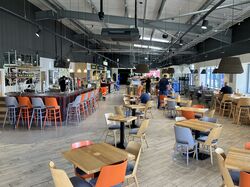
As set out in the roadside facilities policy, MTs and TRTs must be no more than two miles from a motorway or trunk road junction and not require drivers to pass through a settlement in order to reach them.
The parking provision at a motorway truckstop should be 0.5% of the motorway's HGV flow. Curiously, as of 2022, motorway truckstops must also provide at least 10 car parking spaces, one space for a car with caravan, one space for a coach and one abnormal load space: this is to prevent people experiencing an emergency from being turned away. Non-trunk A-road truckstops need to work with the authorities to decide suitable parking provision.
Other than this their required facilities are pretty much the same as what is expected of a full service area, be it an MSA or a TRSA, the main difference being that A-road truckstops aren't required to sell fuel or charge electric vehicles, but are required to offer showers. This clause means you could have an electric charging truckstop be signposted from the road, which is different to the policy for cars. Non-qualifying truckstops are no longer allowed to be built at motorway junctions in case this prevents a qualifying truckstop from being built.
Truckstops may also double-up as an operating centre, subject to an assessment on the impact it would have, where HGVs can be parked up for the night and drivers return home in their regular vehicles. Unlike service areas, truckstops are allowed to attract traffic from surrounding roads.
Following the fuel crisis of 2021, the policy was updated to contain more rules for truckstops. It now says that former truckstops must not be converted to a different use, unless it's clear that a truckstop isn't needed. It also says that National Highways should work with local authorities to ensure that local plans acknowledge areas where more HGV parking is needed.
Spacing and Locations
The regulations state that facilities for HGVs (be it a service area or truckstop) must be available every 14 miles on a motorway, and every 20 minutes on a non-motorway A-road. In cases where that gap is more than 28 miles or 30 minutes respectively, a truckstop is not suitable, as a full service area should be built. Where that gap is less but more facilities are needed, National Highways should "support the case", so long as no safety issues are caused by any close spacing.
These figures were reduced in 2022; until then, the spacing had been 40 miles apart.
There are few requirements for the location of truckstops on trunk roads. Whether on a motorway or a non-motorway trunk road, a proposed new truckstop will often have to provide evidence that there is demand for a new facility, in order to justify what is often an unpopular development.
Road Signs
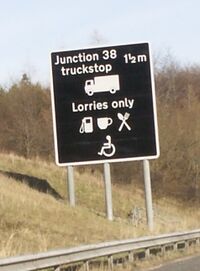
The truckstop road signs were finally clarified in 2025, after much confusion.
Now, all truckstops must use white-on-black signs using the label "truckstop" (one word), which otherwise mirror the motorway service area and A-road service area equivalents. This includes the optional use of six corporate brand logos on motorway signs, and the optional use of panels such as "not 24 hrs" or "fuel only 24 hrs". The legend "lorries only" is, strangely, optional.
There should then be further white-on-black "Truckstop" panels added to existing signs, bringing people to the entrance, with adding the name being optional. Motorway truckstops should appear on any Remote Distance/'List' sign, with a lorry symbol next to their name.
Places which don't qualify for full truckstop signage may still be signposted at a junction as parking for HGVs, so long as overnight parking is available. The regulations call this "Trunk Road Truckstops (not meeting criteria)", and each example is judged on its merits by the local route manager.
Confusion
Until everything was formalised in 2008, truckstop signs were usually improvised by highway authorities on a case-by-case basis, using something similar to the usual 'Services' signage. This led to a number of examples with blue or green signs, such as at Carnforth and Rugby.
The 2008 clarification somehow managed to introduce more confusion. Motorways were permitted to have the new white-on-black truckstop signs. They then said that motorway truckstops must not appear on the Remote Distance/'List' sign, which was illustrated by an example which did show a truckstop being advertised on the sign. The result was a situation where the Remote Distance/'List' sign was allowed to advertise truckstops, but you weren't allowed to use it.
Trunk Road Truckstops were supposed to be referred to as 'lorries only services', using black-on-white signs that make it clear that truckstops are called "services". But there wasn't anything forbidding the black signs on A-roads, in fact the 2016 regulations stated clearly that the black sign may be used for "a non-motorway truckstop", and the 2018 Traffic Signs Manual suggested black signs must be used for all "lorries only" facilities.
These signs were all non-prescribed until 2016: until then they were guidelines only.